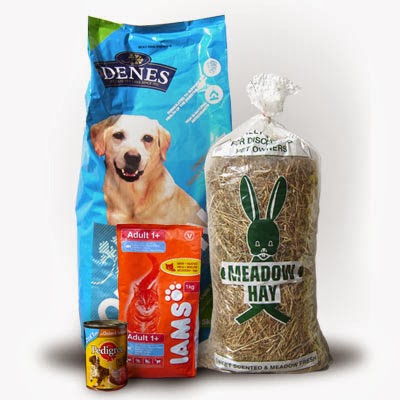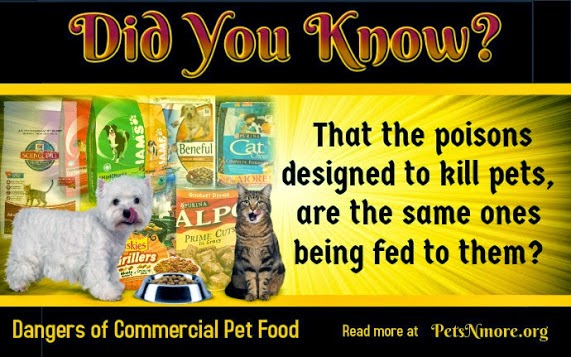90 Percent of Pet Foods May Cause Disease in Your Pet...90 percent of pet foods out there contain totally inappropriate ingredients that are not nourishing and actually create low-grade inflammatory processes, diabetes and obesity.
The sad truth is that many of the bad ingredients in commercial pet foods sold in grocery stores and veterinary clinics help provide patients for vets.
The sad truth is that many of the bad ingredients in commercial pet foods sold in grocery stores and veterinary clinics help provide patients for vets.
Chemicals in Pet Food
Chemicals in Pet food are dangerous to your cat and dog. Many chemicals in pet foods are added to improve the taste, stability, characteristics, or appearance of the food. The chemicals used to euthanize zoo animals - dogs and cats can survive the cooking process, which means these chemicals end up in cat and dog food, and ultimately in your pet.
Euthanized cats and dogs often end up in rendering vats along with other questionable material to make meat meal, and meat and bone meal.This can be problematic because sodium pento-barbital can withstand the heat from rendering.
 |
To Read The Story Click Here |
In short, that means the poisons designed to kill pets are the same ones being fed to them. Chemicals in pet food provide no nutritional value.
Additives include emulsifiers to prevent water and fat from separating, antioxidants to prevent fat from turning rancid, and artificial colors and flavors to make the product more attractive to consumers and more palatable to their companion animals.
Adding chemicals in pet food originated thousands of years ago with spices, natural preservatives, and ripening agents.
In the last 40 years, however, the number of food additives has greatly increased. Chemicals in pet foods are used to help preserve the food so they stay fresh and appealing to our animal companions.
Canning is a preserving process itself, so canned foods contain less preservatives than dry foods.
Some preservatives are added to ingredients or raw materials by the suppliers, and others may be added by the manufacturer.
Because manufacturers need to ensure that dry foods have a long shelf life to remain edible after shipping and prolonged storage, fats used in pet foods are preserved with either synthetic or "natural" preservatives.
Synthetic preservatives include butylated hydroxyanisole (BHA) and butylated hydroxytoluene (BHT), propyl gallate, propylene glycol (also used as a less-toxic version of automotive antifreeze), and ethoxyquin.
For these antioxidants, there is little information documenting their toxicity, safety, interactions, or chronic use in pet foods that may be eaten every day for the life of the animal.
Some chemicals in pet food are potentially cancer-causing agents such as BHA, BHT, and ethoxyquin, which are permitted at relatively low levels.
The use of these chemicals in pet foods has not been thoroughly studied, and long term build-up of these agents may ultimately be harmful.
 |
| MONSANTO tested on Rats This is the outcome! |
Even though Monsanto found no significant toxicity associated with its own product, in July 1997, the FDA's Center for Veterinary Medicine requested that manufacturers voluntarily reduce the maximum level for ethoxyquin by half, to 75 parts per million.
While some pet food critics and veterinarians believe that ethoxyquin is a major cause of disease, skin problems, and infertility in dogs, others claim it is the safest, strongest, most stable preservative available for pet food. Which do you believe?
Ethoxyquin is approved for use in human food for preserving spices, such as cayenne and chili powder, at a level of 100 ppm -- but it would be very difficult to consume as much chili powder every day as a dog would eat dry food. Ethoxyquin has never been tested for safety in cats.
To read more about the shocking ingredients that are put in pet foods along with the dangers it poses for our pets, click here
While some pet food critics and veterinarians believe that ethoxyquin is a major cause of disease, skin problems, and infertility in dogs, others claim it is the safest, strongest, most stable preservative available for pet food. Which do you believe?
Ethoxyquin is approved for use in human food for preserving spices, such as cayenne and chili powder, at a level of 100 ppm -- but it would be very difficult to consume as much chili powder every day as a dog would eat dry food. Ethoxyquin has never been tested for safety in cats.
To read more about the shocking ingredients that are put in pet foods along with the dangers it poses for our pets, click here
Pets can be adopted from the Humane Society, SPCA, Shelters, adopted from a Rescue Group or rescued off the street, their contribution to the household they are in, is invaluable.



.jpg)